Samsung Galaxy S 5 Review
by Anand Lal Shimpi & Joshua Ho on April 8, 2014 12:00 AM EST- Posted in
- Smartphones
- Samsung
- Mobile
- Galaxy S 5
CPU Performance
The Galaxy S 5 marks the second Snapdragon 801 based device we've reviewed at AnandTech, the first being HTC's M8. I've gone through the Snapdragon 801 in depth already, but we're basically dealing with a reasonable upgrade to Snapdragon 800 on an improved 28nm HPm process. The bulk of the improvements impact GPU and ISP performance, but the SoC is just better overall. GS5 owners are lucky as all versions of the device that use Qualcomm silicon feature the MSM8974AC v3 SKU, which includes four 2.5GHz Krait 400 cores and a 578MHz Adreno 330 GPU.
| Snapdragon 800/801 Breakdown | ||||||||||
| SoC Version | Model | Max CPU Frequency | Max GPU Frequency | ISP | eMMC | DSDA | Memory IF | |||
| MSM8974VV | v2 | S800 | 2.2GHz | 450MHz | 320MHz | 4.5 | N | 800MHz | ||
| MSM8974AA | v2 | S800 | 2.3GHz | 450MHz | 320MHz | 4.5 | N | 800MHz | ||
| MSM8974AB | v2 | S800 | 2.3GHz | 550MHz | 320MHz | 4.5 | N | 933MHz | ||
| MSM8974AA | v3 | S801 | 2.3GHz | 450MHz | 320MHz | 5.0 | Y | 800MHz | ||
| MSM8974AB | v3 | S801 | 2.3GHz | 578MHz | 465MHz | 5.0 | Y | 933MHz | ||
| MSM8974AC | v3 | S801 | 2.5GHz | 578MHz | 465MHz | 5.0 | Y | 933MHz | ||
Although Samsung was the first major OEM to be caught cheating in Android benchmarks, it appears to have completely abandoned the practice with the Galaxy S 5's shipping software. Not only was I unable to find any evidence of the old cheats, I couldn't find any evidence of HTC's new subtle cheating either. The Galaxy S 5 appears to be clean as far as I can tell. Kudos to Samsung on doing the right thing, and I hope all other OEMs take this as a sign to stop the silliness.
For our performance tests I turned to our usual suite of browser and native applications. If there's one obvious takeaway from our CPU tests it's that despite having faster silicon than HTC's M8, the GS5 isn't always faster. I believe this has more to do with thermals than anything else. HTC's metal chassis is able to do a better job of dissipating heat than the GS5's plastic chassis. I don't believe there's a substantial impact on user experience, but it's interesting to note how choice in materials can have a performance impact like this.
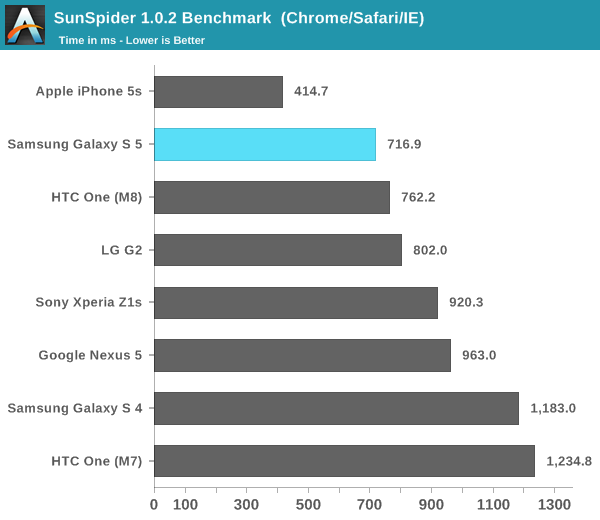
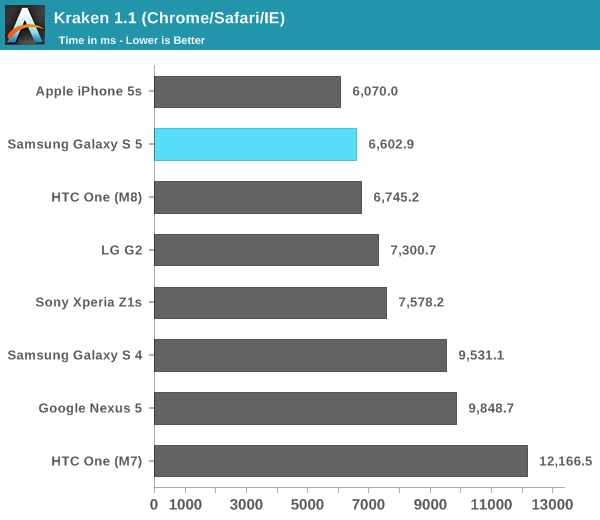
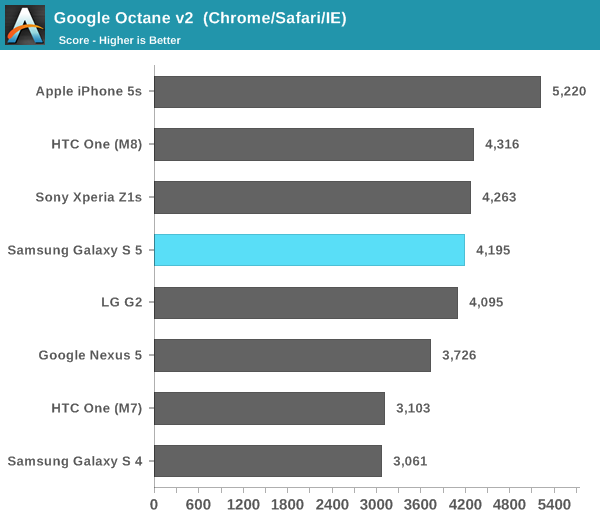
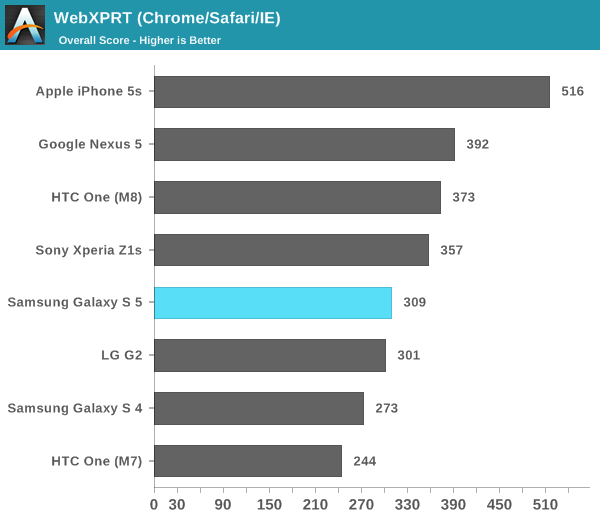
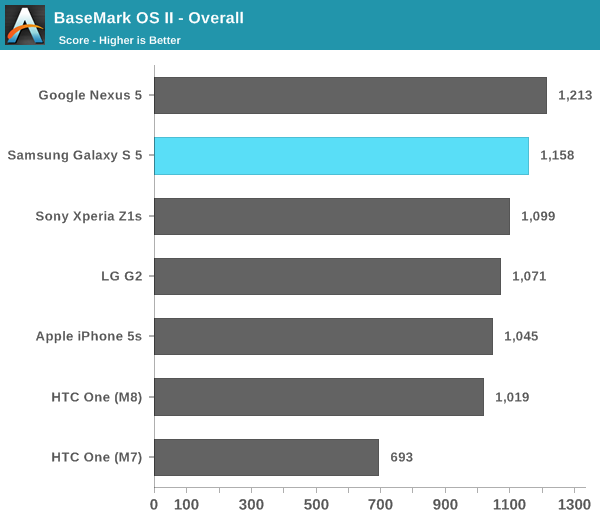
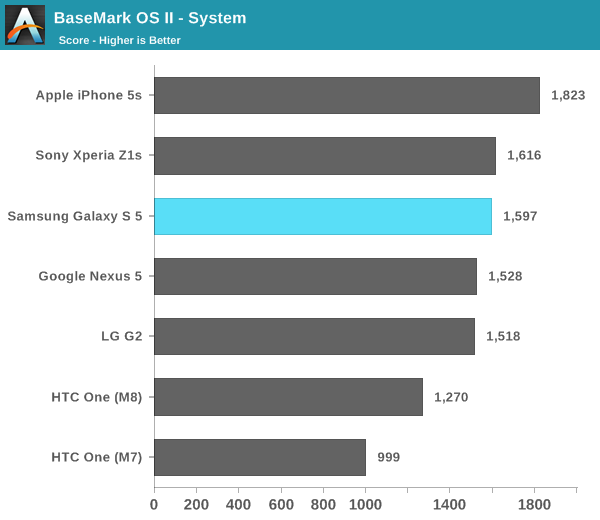
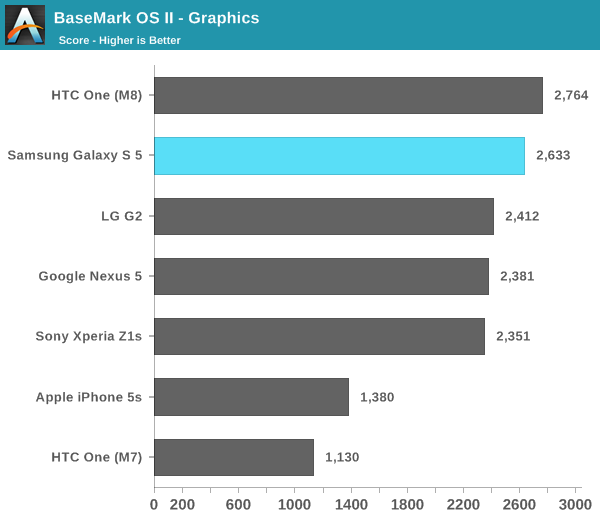

GPU Performance
GPU performance remains where we see the biggest benefit from Snapdragon 801 vs. 800, and since the GPU gains are almost entirely due to frequency scaling it's not too surprising that the M8 pulls ahead of the GS5 here in most cases.
There aren't any surprises here. The Adreno 330 in the Galaxy S 5 is more than capable of driving the device's 1080p display both in current and near term future 3D games.
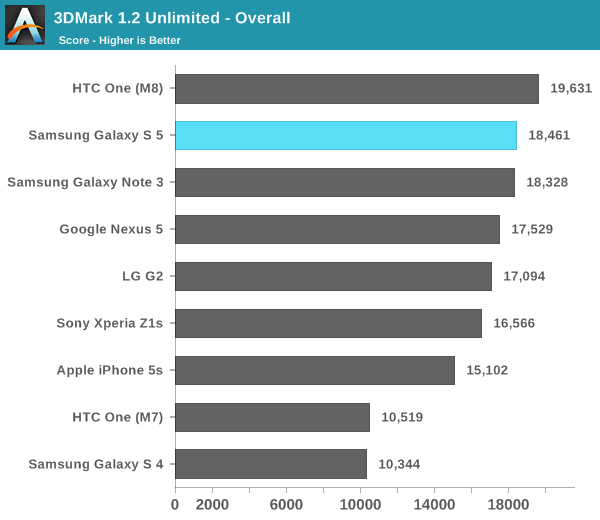
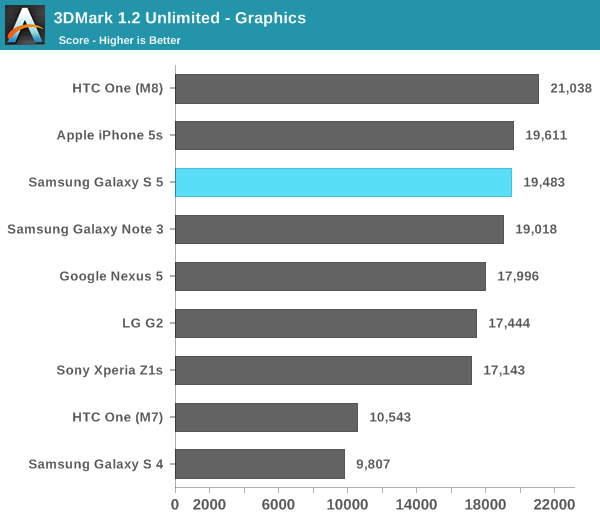
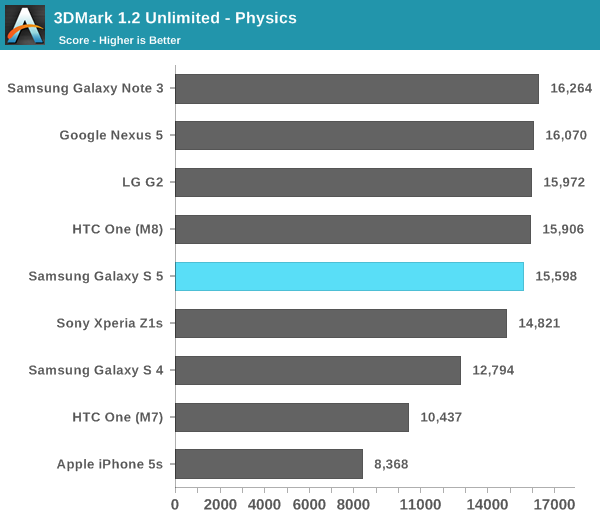
BaseMark X 1.1
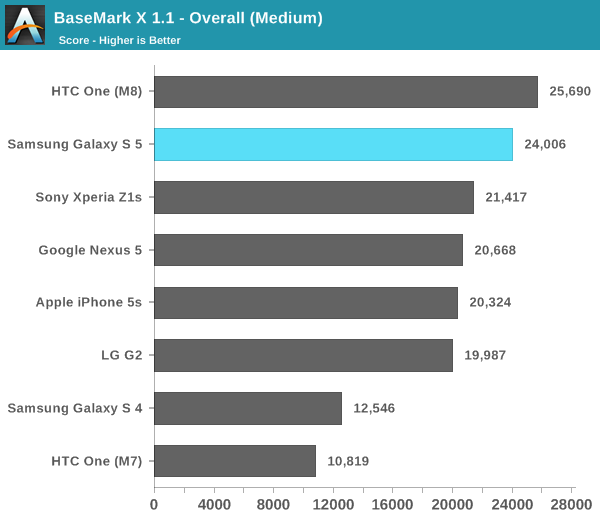

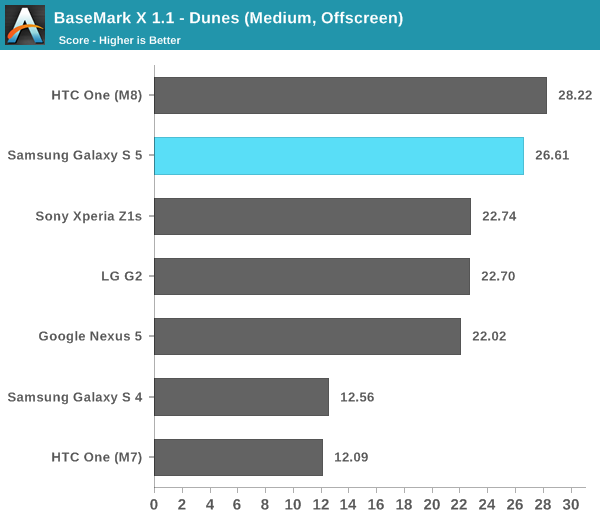
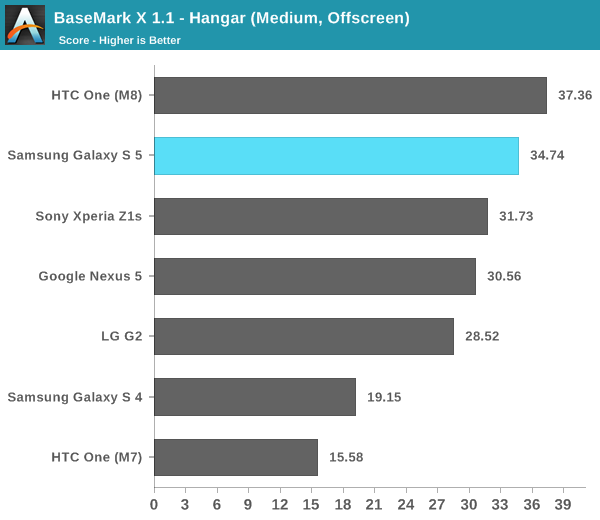

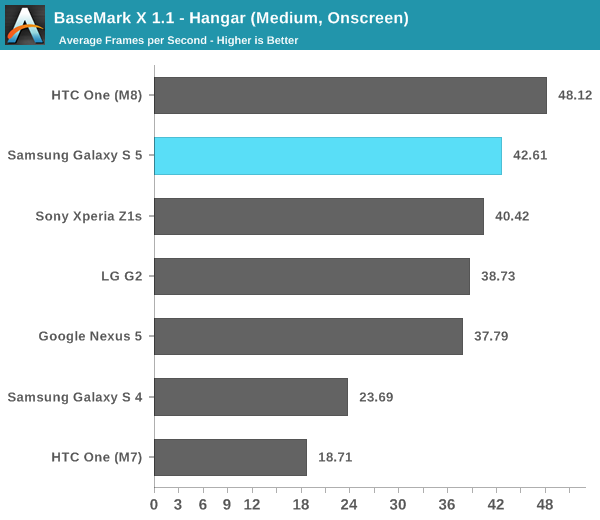
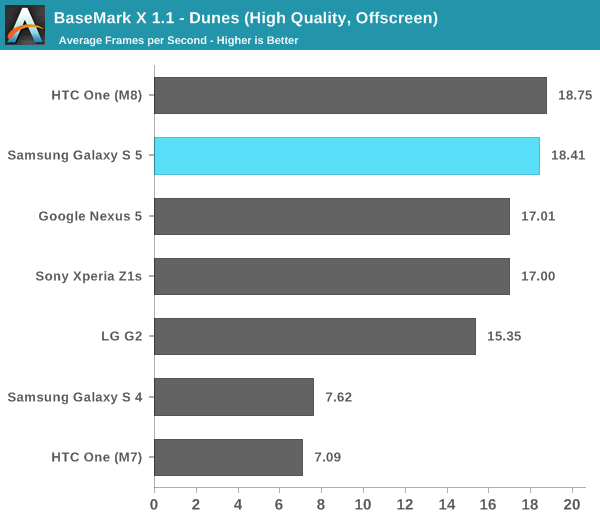
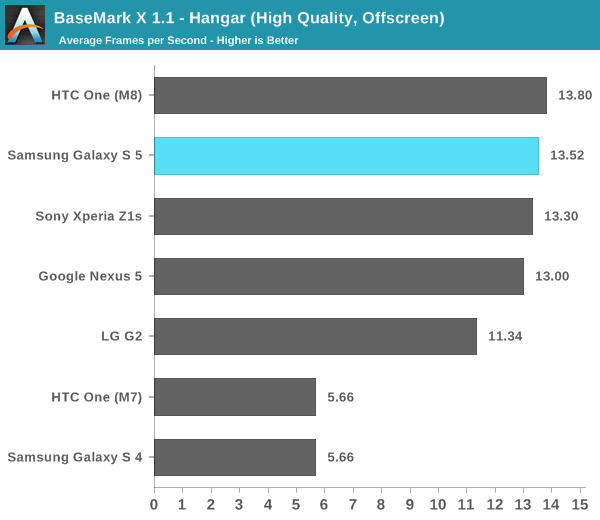
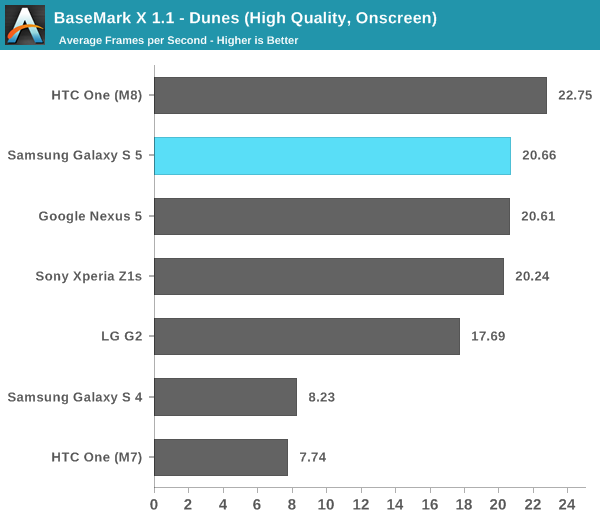
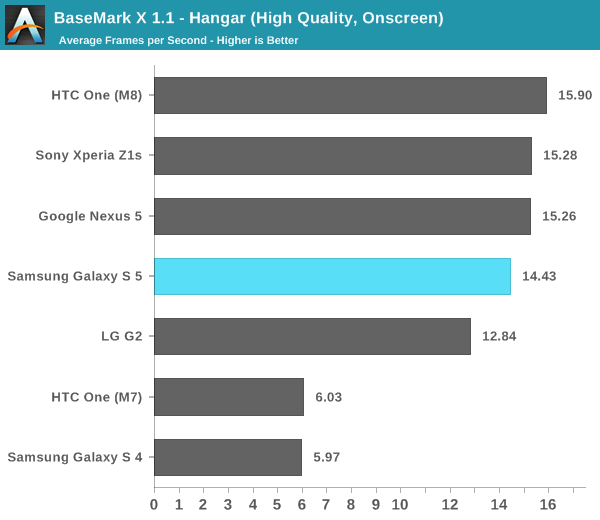
GFXBench 3.0
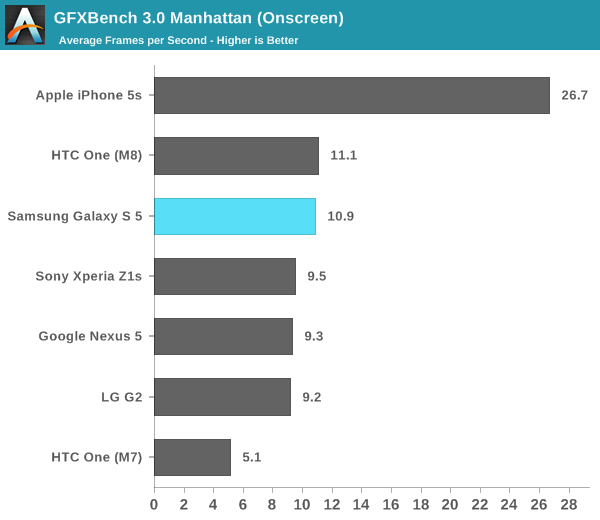
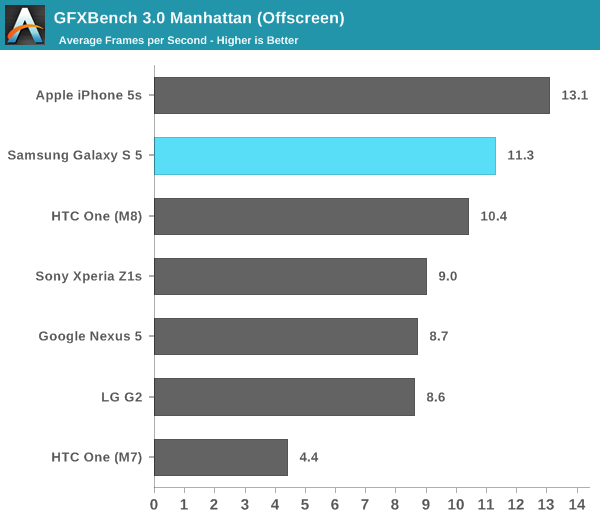
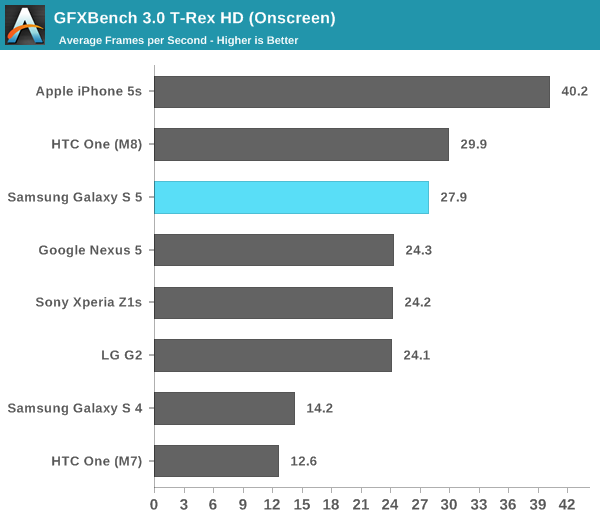
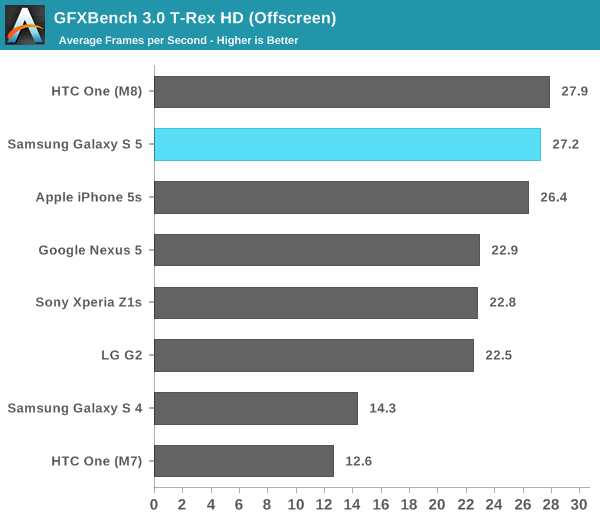

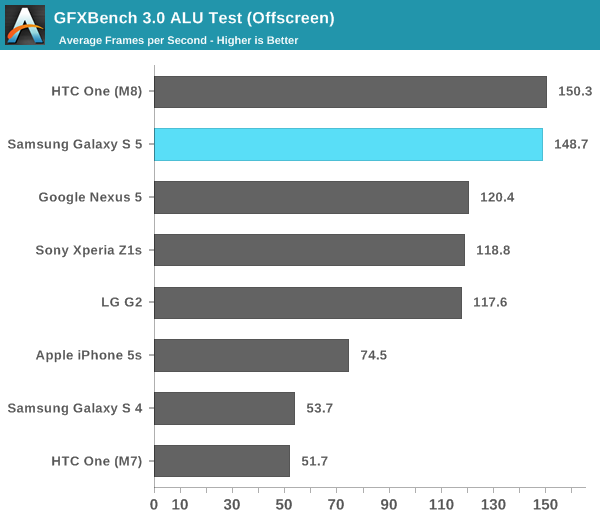


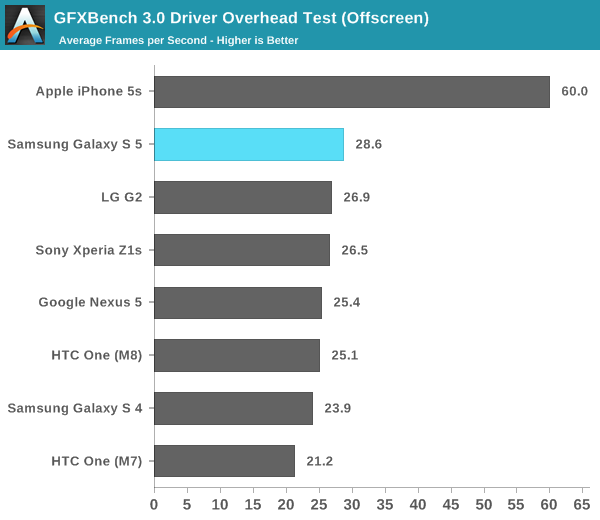
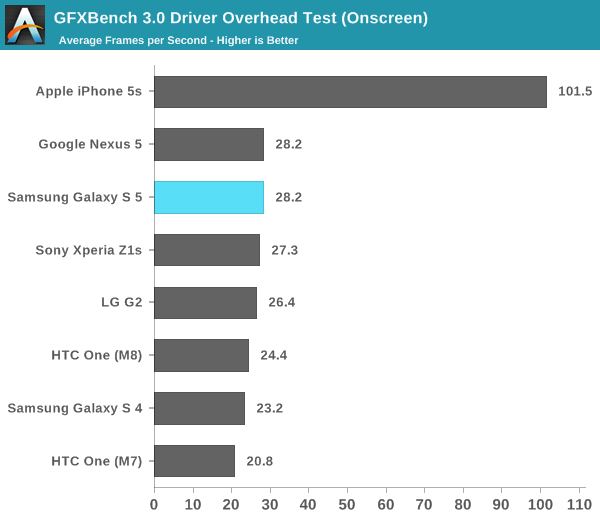
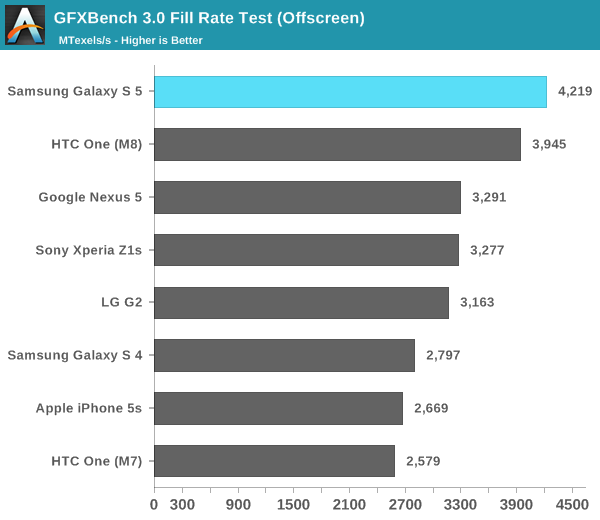
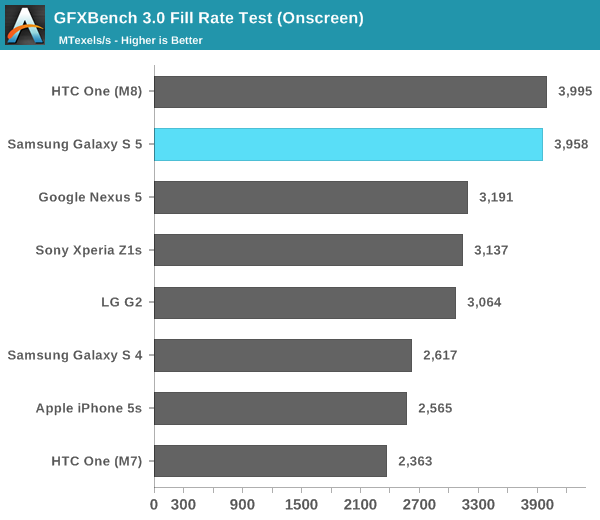
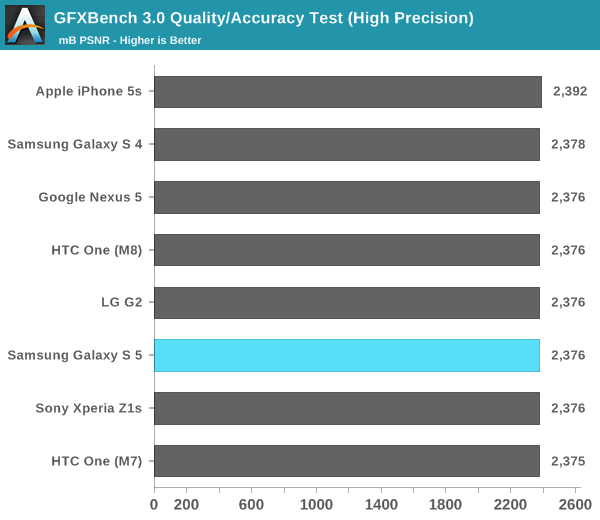
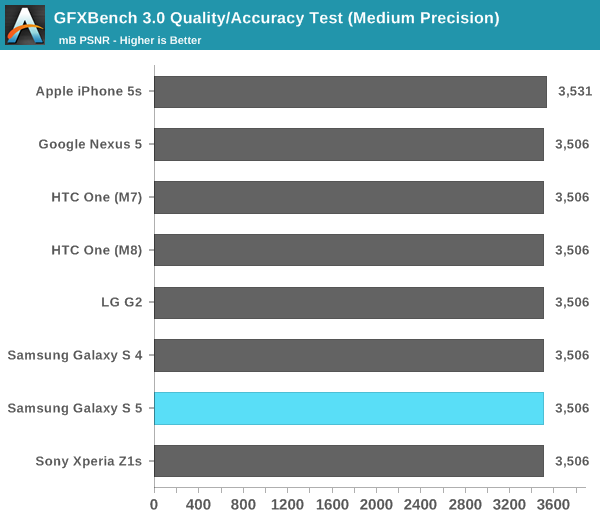
NAND Performance
The GS5 ships with 16GB or 32GB of NAND internally on an integrated eMMC device. Expansion is supported through a microSD card slot behind the removable back cover. Although the Snapdragon 801 inside supports eMMC 5.0, that alone doesn't guarantee a substantial increase in NAND performance. Keep in mind that most OEMs find multiple sources for their internal eMMC/NAND solutions, so what I'm testing here may only be representative of a portion of all GS5 devices.
Samsung sampled a 16GB GS5 review device. I put it through our usual random/sequential IO tests on a 100MB span of LBAs.
Random read performance is disappointing, it falls behind all modern devices we've tested. Random write performance is middle-of-the-road at best. It's unclear to me if this is a cost optimization or a lack of concern for NAND performance, but either way I'd rather see these metrics improve rather than regress.
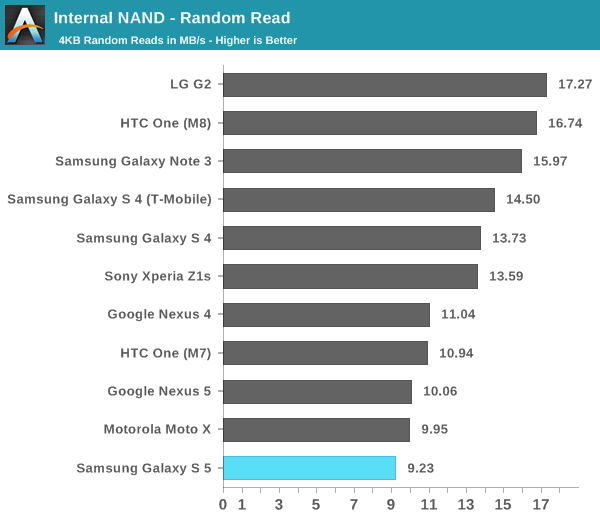
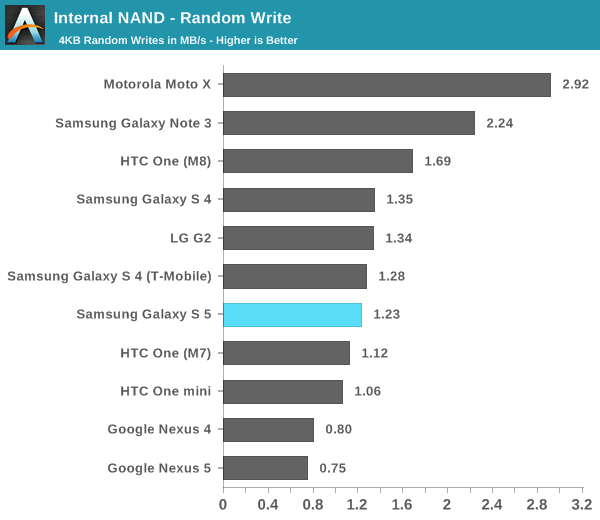
Sequential read/write performance both improve handsomely compared to the Galaxy S 4. I can see why Samsung would want to optimize for these two cases as they are quite common in regular usage, but random read/write performance can also significantly impact user experience.
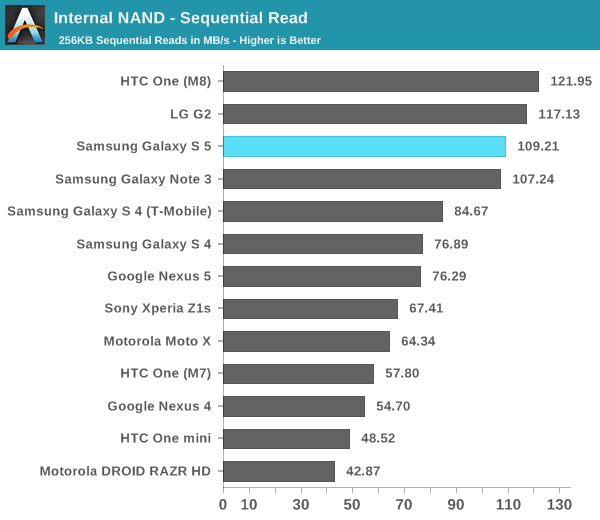
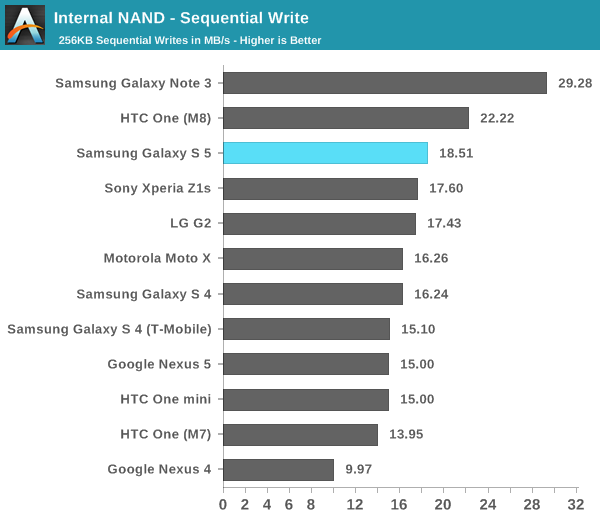










296 Comments
View All Comments
hlovatt - Tuesday, April 8, 2014 - link
Plastic body, pentile, not the brightest display, not the best build quality, not the best feel in the hand, not the best camera, not the best processor, could be the last of the 32 bit top end phones, not the best finger scanner, not the best styling, hard to use one handed - but a high price - seems ho hum to me. (But it does have the most advertising, so maybe they are spending their money wisely :).Ev1lAsh - Wednesday, April 9, 2014 - link
I know its not as important with the quicker shutter speed, but personally I was hoping for OIS (in h/w), as I seem to have very shaky hands judging by some of the videos I've shot over the years..theuglyman0war - Friday, April 25, 2014 - link
2nd this...image stabilization race competition would be nice for the market in general
jabber - Tuesday, April 8, 2014 - link
Actually I'm pleased that we are now at the stage of purely refinement rather than revolutionary features. At least from here on in we should get products that actually work and work well rather than half baked features that are strangely absent from the next version.BoneAT - Tuesday, April 8, 2014 - link
DiplayMate calls S5 screen best mobile display ever, it has awesome battery stats, has great grip, survives huge drops (S5 vs. Tesla Model Sm youtube) some of the best battery stats, IP68 level protection (1h in pool, youtube), excellent photo and incredible 4k video recording quality, fast fluid performance (pity Anand didn't use stock browser which is new SunSpider champ) & the the usual suspects: multi-window, rich camera interface, airview, now battery saver, fingerprint payment & super-charging.Individually you could say it's not the 2nd coming, but all things combined, build, grip, camera, battery, screen, performance, features, it's a bigger leap forward than any Android device since the Note 2.
grayson_carr - Tuesday, April 8, 2014 - link
Based on the data shown here, Display Mate probably received a nice fat check from Samsung. It's a good display, no doubt, but it's far from what DisplayMate portrayed it to be.ltcommanderdata - Tuesday, April 8, 2014 - link
DisplayMate's pre-release unit may have been cherry-picked by Samsung so their results may be accurate for the device given, but may not be representative of every unit.comomolo - Tuesday, April 8, 2014 - link
Or Display Mate might have the better equipment and expertise in -errr...- display calibration technology, which they have been doing for some million years or so and beg to differ with Anand's conclusions?comomolo - Tuesday, April 8, 2014 - link
That's a trully deep argument there... (facepalm). I guess people at Display Mate should now believe Apple is paying Anand, right?grayson_carr - Wednesday, April 9, 2014 - link
Well then. I didn't know that my comments needed to be backed by deep arguments. For one, the reason I'm here is because I've been reading Anandtech for nearly 15 years and know that I can trust them to be competent and objective. I'm admittedly not as familiar with DisplayMate's reviews (though I've known the name for a long time), so I don't know how trustworthy they usually are, but based on my own experience with the Galaxy S5, I do find it a bit surprising that they think it has the best mobile display ever. When compared to my Nexus 5 and my wife's iPhone 5, whites on the GS5 had a green tint, there was banding in some gradients, and there was noticeable smearing when scrolling quickly. So, you're telling me the best mobile display can't even display white properly? My rudimentary findings line up more with Anandtech's findings, and plus I already trusted Anandtech, so yeah, I'm calling BS on DisplayMate's claim. The GS5 has a good display for sure, but after hearing what DisplayMate thought, I was expecting more. I think ltcommanderdata could be on to something. DisplayMate might have received a "special" cherry picked GS5 with a custom calibration or something. I would like them to review a random production unit they buy themselves.